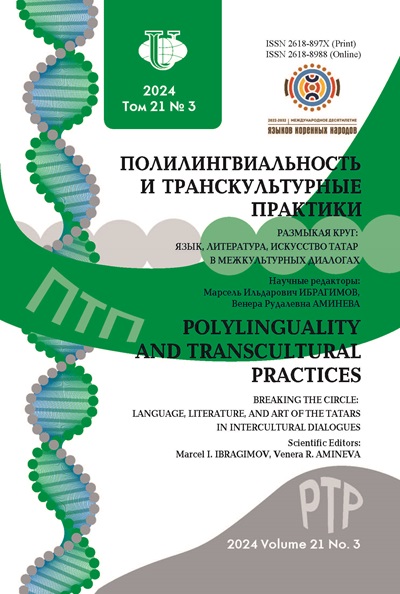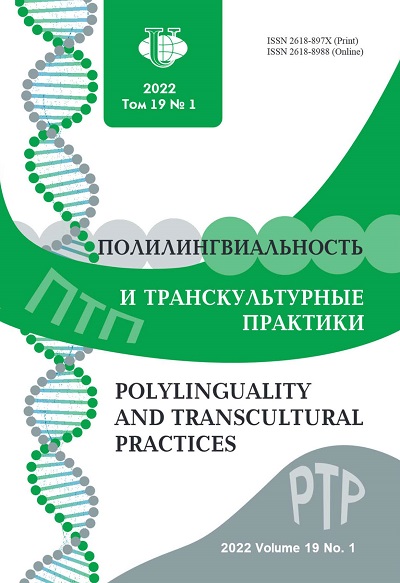Занимательность на занятиях по письму с детьми-билингвами
- Авторы: Беженарь О.А.1
-
Учреждения:
- Миланский государственный университет
- Выпуск: Том 19, № 1 (2022)
- Страницы: 124-130
- Раздел: Билингвальное образование
- URL: https://journals.rudn.ru/polylinguality/article/view/30501
- DOI: https://doi.org/10.22363/2618-897X-2022-19-1-124-130
Цитировать
Полный текст
Аннотация
В статье рассматриваются проблемы, связанные с обучением детей-билингвов письму, и пути их решения. Предлагаемый набор практических приемов работы имеет особую актуальность в условиях негативного отношения к каллиграфии и чистописанию в эпоху информационно-коммуникативных технологий, ограниченного количества учебных часов и недостаточным количеством пособий по письму для детей-билингвов.
Полный текст
Введение Одной из главных целей обучения в начальной школе является обучение чтению и письму, так как в дальнейшем от качества этих навыков будет зависеть успешность обучения школьника в старших классах в силу того, что именно чтение и письмо станут основными средствами обработки информации. Несмотря на то, что формирование графических навыков является первой ступенью в обучении письменной речи [1. С. 71], которую Л.С. Выготский называет «алгеброй речи, наиболее трудной и сложной формой намеренной и сознательной речевой деятельности» человека [2. С. 367], в настоящее время мы все чаще наблюдаем скептическое отношение к каллиграфии и чистописанию ввиду того, что в век развитых компьютерных технологий в них нет практической необходимости. Программа начальной школы по обучению русской графике за один урок предусматривает знакомство с несколькими буквами, образцы написания букв предъявляются один раз, систематические упражнения по чистописанию сведены до минимума и т.д. В данной статье мы хотели бы привлечь внимание к данной проблеме и представить возможные пути ее решения. Обсуждение В ходе развития психологии, нейропсихологии, логопедии и педагогики тема освоения детьми элементарных графических навыков или элементарных навыков письма привлекала многих авторов XX века, отмечавших исключительную сложность и важность процесса письма (А.Р. Лурия, Л.С. Выготский, А.Н. Корнев, В.Е. Гурьянов, а также М. Монтессори, Ю.И. Фаусек, Е. Хилтунен). Однако вопрос о том, каким образом идет усвоение письма у детей-билингвов, рассматривали немногие [3. С. 55-68]. Уроки чистописания в начальной школе обычно считаются скучным видом занятий. В трудах известного итальянского педагога М. Монтессори мы находим ответ на вопрос, почему так происходит. Ученый утверждает, что желание писать и читать у детей пропадает к концу сенситивного периода развития языка (4,5- 6 лет) [4. С. 4]. Получается, что, когда ребенок идет в школу, учить писать его уже поздно, так как после семи лет наблюдается спад интереса к письму, и занятия письмом становятся настоящей пыткой для первоклассников. Но по мнению А.Н. Корнева, «чтобы овладение письмом стало возможным, языковые и когнитивные способности ребенка должны достичь определенного, минимально необходимого уровня зрелости... хронологически этот этап совпадает с моментом поступления ребенка в школу...» [5. С. 6]. Условия билингвизма - это условия особые. В них необходимо избежать двойной нагрузки (речь идет о посещении двух школ: основной итальянской и субботней русской). Поэтому в учебно-образовательном русском центре «Академия» было принято решение: в первый класс русской школы дети-билингвы идут на год позже начала обучения в итальянской школе. К этому моменту у них уже сформированы навыки письма и чтения на итальянском языке, которые могут быть успешно перенесены в русский язык. Но здесь есть и подводные камни: например, в итальянской графике традиционно принято прямое письмо, поэтому выработать у итало-русских билингвов наклонный почерк очень трудно. Ситуация осложняется отсутствием специализированных учебных пособий, написанных специально для зарубежных школ. Во многих имеющихся учебниках по русскому языку и в рабочих тетрадях внимание детей, только что научившихся писать, фокусируется только на орфографических правилах. Поэтому вначале остановимся на том, как складываются орфографические навыки. По поводу орфографических правил, вводимых уже в 1-м классе, есть разные мнения. Заслуживает внимания опыт работы известного блогера, преподавателя РКИ, основателя русской школы «Росинка» в Токио Дарьи Куматренко, которая предложила модель обучения, доказавшую свою эффективность на практике. Перед тем как начинать знакомство детей с орфографическими правилами, Д. Куматренко считает полезными следующие виды работы: - для исключения неорфографических ошибок важно развитие фонематиче-ского слуха; - для понимания того, что устная речь отличается от письменной, нужны дик-танты; - для осознания того, что слово состоит из значимых элементов (морфем), полезно составление пиктографических схем к однокоренным словам без использования терминологии; - для понимания функций разных частей речи дети должны осознать деление слов на классы слов: обозначающие предметы, признаки и действия; - для подготовки к работе с пунктуацией - чтение длинных запутанных пред-ложений [6]. С таким подходом трудно не согласиться. Поэтому в русском образовательном центре «Академия» начальная школа занимается по линейке учебников, разработанной коллективом авторов - В.В. Дроновым, И.В. Мальцевой, В.П. Синячкиным, Е.А. Хамраевой, Г.В. Хрусловым, А.В. Тряпельниковым [7-10]. Избегая научной терминологии, авторы этих учебников предлагают задания, соответствующие возрасту и уровню развития билингвальных первоклассников. За 30 рабочих суббот планируется познакомить ребят не только с написанием всех 33 букв русского алфавита, но и отработать такие темы, как перенос слова, твердые и мягкие согласные, звонкие и глухие согласные, правила правописания в сочетании ЖИ-ШИ, ЧА-ЩА, ЧУ-ЩУ, корень слова и окончание, использование прописной буквы, понятие о частях речи (существительные, прилагательные, глаголы, предлоги), связь слов в предложении, слово и предложение, текст. Подчеркнем, что, работая по этой системе, мы стараемся избегать необоснованного форсирования темпа обучения (например, знакомства одновременно с 2-3 буквами за урок). Мы скорректировали систему в соответствии с конкретными условиями обучения. Например, мы исключили из программы тему правописания сочетаний ЧК-ЧН, так как это неактуально в нашей аудитории. А обучение графике мы решили проводить в соответствии с последовательностью основных операций в акте письма, которые выделил А.Р. Лурия [11]: анализ звука, подлежащего написанию, соотнесение выделенной фонемы со зрительным образом буквы, порядок написания линий этой буквы (последовательность движения руки), одновременно с написанием буквы проговаривается звук, тем самым осуществляется кинестетический анализ, уточняющий характер звука. Урок письма включает следующие этапы: 1) знакомство с темой урока по учебнику «Русский язык. 1 класс: учебник для зарубежных школ» [6]; 2) демонстрация и чтение преподавателем прописной буквы в изолированной позиции; 3) написание прописной буквы на классной доске с объяснением последовательности движений (доска с разлиновкой в виде косых линий); 4) упражнение в написании прописной буквы; 5) обсуждение ошибок; 6) демонстрация преподавателем строчной буквы; произношение соответствующего звука в изолированной позиции; 7) написание строчной буквы на доске с объяснением последовательности написания линий; 8) написание строчной буквы детьми несколько раз; 9) обсуждение ошибок; 10) работа с прописями (во время этой работы предусмотрена пауза для отдыха руки); 11) игры/занимательные задания. Генераторы прописей Большую помощь в обучении билингвов русскому письму оказывают последние достижения современных информационно-коммуникативных технологий (далее ИКТ): с помощью установленных на компьютере специальных программ, а также с помощью таких сайтов, как http://tobemum.ru/deti/kak-nauchit/generatorpropisi или https://childdevelop.ru/generator/letters/propisi довольно быстро можно подготовить качественные прописи. Подробнее о возможностях современных ИКТ и подготовке упражнений в зависимости от целевой аудитории мы написали в статье «Обучение русской графике...» [12]. Листы с разлиновкой от самого крупного до самого мелкого размера и интервалами разной ширины можно найти на специальных сайтах. Занимательные задания Обычно состав групп и классов в школах дополнительного дня неоднороден, в первый класс приходят семилетние дети самого разного уровня подготовки. В основном это дети, которые посещали русскую школу по субботам, причем некоторые это делали нерегулярно. Большинство детей в классе готовы к освоению письма традиционными методами, однако есть и те, кто готов при столкновении с первыми же трудностями бросить школу. Поэтому главной задачей для нас является пробудить заинтересованность в предмете, любознательность и желание учиться. С этой целью в конце каждого урока мы проводим новую игру. Ниже даются описания некоторых игр, особенно полюбившихся детям. «Волшебная веревочка» Реквизит: веревочка. Задание: выложи с помощью веревочки букву «А». Описание: на ровной поверхности дети «пишут» букву с помощью веревочки. Цель: С помощью веревочки легче понять принцип написания некоторых букв. Например, прописную букву «а» пишем, не отрывая карандаш от листа. Кто быстрее? Реквизит: Песочные часы на 10 секунд в минуту, доска/бумага, мел/карандаши. Задание: кто напишет больше букв «Ж» за 10 секунд/за минуту. Описание: дети пишут на доске буквы/слова на время. Цель: форсирование скорости письма. Принцип «пишем не только красиво, но и быстро» должен быть усвоен с самого начала. Как 100 лет назад Реквизит: перьевые ручки, чернила, бумага. Задание: написать буквы, слово, короткое предложение. Описание: дети учатся писать чернилами. Цель: научить писать перьевой ручкой; заинтересовать техникой каллиграфического письма и упражнять в таком письме; познакомить с историей ручки, а также со словами чернила, чернильница, перо, перьевая ручка. Устное анкетирование и результаты анкетирования По истечении 10 рабочих недель нами было проведено устное анкетирование первоклассников, в ходе которого мы выясняли, какие буквы вызывают у них наибольшую трудность, какие упражнения они считают наиболее полезными и интересными, какие упражнения они бы показали своим итальянским друзьям, им также задавался вопрос, что они думают по поводу того, зачем/для чего люди учатся писать. Результаты анкетирования показали, что «трудных» букв для детей нет, а больше всего им нравятся игры «Как сто лет назад» и «Кто быстрее?», в которые они с удовольствием бы поиграли и в итальянской школе. На вопрос «Для чего люди учатся писать?» ответы были получены самые разные: чтобы хорошо учиться, чтобы научиться передавать свои мысли, чтобы писать письма, чтобы ничего не забывать, чтобы писать открытки родственникам (как оказалось впоследствии, это одно из самых настойчивых пожеланий родителей). Выводы Резюмируя сказанное, можно сделать следующий вывод: проведенное нами анкетирование детей и опрос родителей, а также достигнутые в ходе опытного обучения результаты позволяют сделать вывод о высокой эффективности освоения русской графики в соответствии с выбранным подходом. Проделанная работа оказалась действенной. Она полностью удовлетворяет запросы педагогов и родителей. Никто из них не говорил о недостатке упражнений на отработку каких-либо элементов или отсутствие качественных прописей, но отмечалась эстетическая составляющая, побуждающая ребенка увлеченно заниматься письмом. Стало очевидным, что понимание важности проблемы, тщательная подготовка учителя к работе над графикой, использование различных форм обучения письму является залогом высокого качества обучения, обеспечивает мотивацию обучающихся, помогает избежать трудностей, с которыми обычно сталкиваются ученики на начальном этапе. Несомненно, что чем успешнее будут выработаны базовые навыки чистописания, тем скорее письмо как сложный вид речи станет естественной потребностью наших детей. Также добавим, что русская каллиграфия является неотъемлемой частью русской культуры, поэтому мы считаем таким важным формирование этого навыка у билингвов.
Об авторах
Оксана Анатольевна Беженарь
Миланский государственный университет
Автор, ответственный за переписку.
Email: oxana.bejenari.rus@gmail.com
ORCID iD: 0000-0001-8236-9079
преподаватель РКИ Миланского государственного университета, учитель начальной школы центра дополнительного образования «Академия» при Ассоциации российских соотечественников в Италии «Алые паруса».
Италия, 20100, Милан, ул. Делле Анде, 4, Начальная школа Рикардо МассаСписок литературы
- Иншакова О.Б. Письмо как «рецептивная ступень» процесса овладения письменной речью младшими школьниками. Наука и школа, 2010. С. 71-74.
- Выготский Л.С. Избранные психологические исследования. М.: Изд-во АПН РСФСР, 1956. С. 39-386. С. 367.
- Contento S. “Crescere nel bilinguismo”, Bellocchi S, Baraldi S. capitolo “Bilinguismo e apprendimento della letto-scrittura: sviluppo tipico e difficolt ”. Roma.: Carocci editore 2012. С. 124.
- Хилтунен Е.А. «Свободное письмо. Дети учатся писать по методу М.Монтессори». М.: Генезис, 2009.
- Корнев А.Н. Нарушения чтения и письма у детей. СПб., 1997.
- Куматренко Д. Орфография: быть или не быть? https://2lingual.livejournal.com/86355.html?fbclid=IwAR2StFY3iaBeFmtd3RUNg0Y7s5mRdHpwgo1vHd6_vj1CCungxsU7bS3iOM
- Дронов В.В., Мальцева И.В., Синячкин В.П. Русский язык. 1 класс: методическое руководство для учителя зарубежных школ. М.: Дрофа, 2009.
- Дронов В.В., Мальцева И.В., Синячкин В.П. Русский язык. 1 класс: учебник для зарубежных школ. М.: Дрофа, 2009.
- Дронов В.В., Мальцева И.В., Синячкин В.П., Хамраева Е.А, Хруслов Г.В. Рабочая тетрадь № 1. М., 2009.
- Дронов В.В., Синячкин В.П., Тряпельников А.В. Русский язык - ДА! М.: РУДН, 2017.
- Лурия А.Р. Очерки психофизиологии письма. М.: Изд-во АПН РСФСР, 1950. URL: http://rus.1september.ru/article.php?ID=200204009 (Дата обращения: 11.08.2017)
- Беженарь О.А. Обучение русской графике: какие упражнения могут сделать эту работу интересной // Pусский язык за рубежом. 2015. № 2. С. 36-41.















